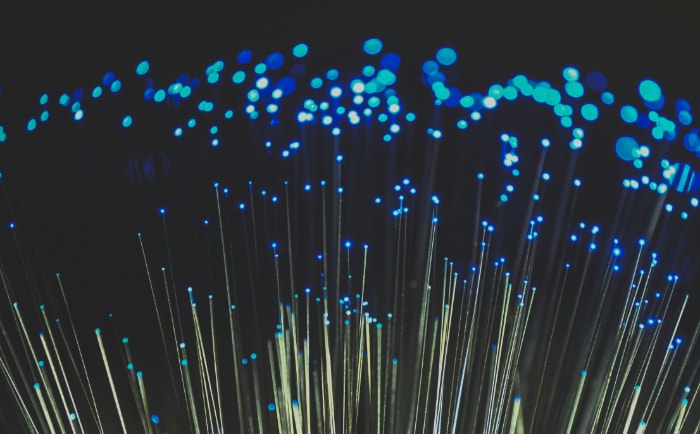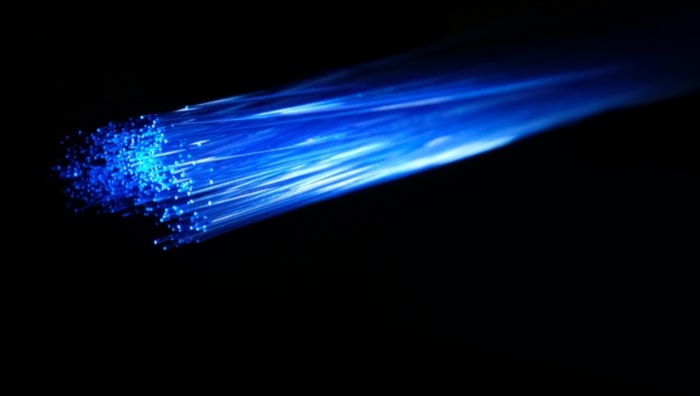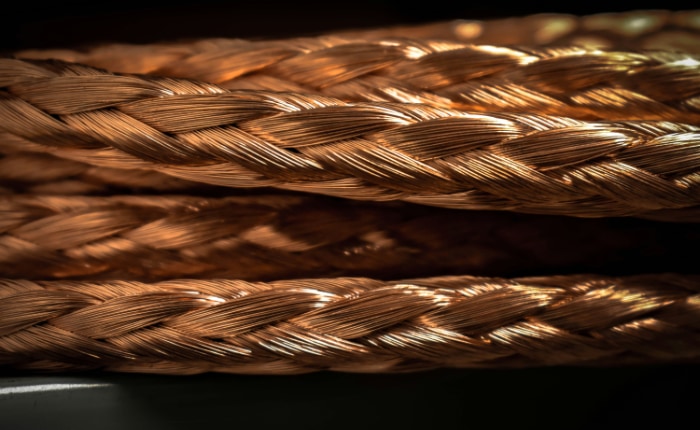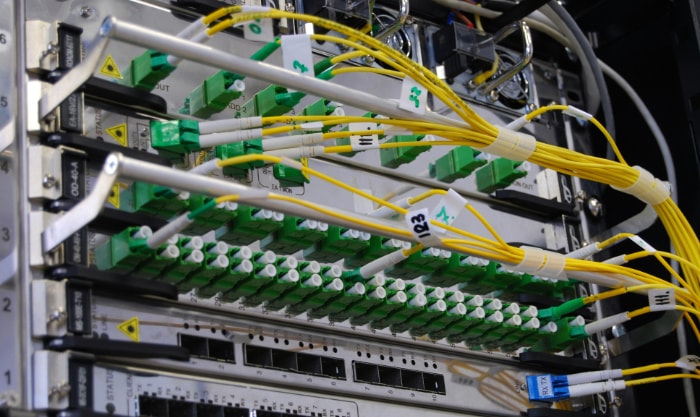Fiber vs. Copper: Unpacking the Network Necessities

Rapid advancements in technology have transformed internet connectivity into a fundamental pillar of modern life, affecting everything from global business operations to our daily social interactions. Amidst this digital revolution, the choice between fiber optic and copper wire technology stands as a critical decision for ensuring robust and efficient internet service.
Bandwidth and Performance
Fast and reliable internet is a fundamental part of our lives, powering everything from streaming services to remote work tools. At the heart of this digital experience is bandwidth, a critical factor that determines how much information can travel over your internet connection at one time.
Both fiber optic and copper cables offer different bandwidth capabilities, directly impacting performance and user experience.
What is Bandwidth?
Bandwidth refers to the maximum amount of data that can be transmitted over an internet connection in a given amount of time, usually measured in megabits per second (Mbps) or gigabits per second (Gbps). Think of it as a highway: the wider it is, the more cars (data) can travel simultaneously without causing congestion (slowdowns).
Fiber Optic vs. Copper Bandwidth
Fiber optic technology shines in bandwidth capabilities, capable of delivering speeds up to 1 Gbps or even higher. This is because fiber uses light to transmit data, which can travel faster and over longer distances without losing signal strength.
On the other hand, copper cables, which transmit data through electrical signals, typically offer lower bandwidth, maxing out around 100 Mbps under optimal conditions.
Impact on Internet Speed and Performance
The difference in bandwidth between fiber and copper directly influences internet speed — the rate at which data is downloaded or uploaded from the internet. High-bandwidth connections, like those provided by fiber, can handle multiple high-demand applications simultaneously, such as streaming 4K video, online gaming, and large file downloads, without a hitch.
Copper's lower bandwidth may struggle under the same load, leading to buffering, delays, and slower download speeds.
Real-World Implications
For households or businesses where internet usage is high and multiple devices are connected simultaneously, fiber’s superior bandwidth offers a smoother, more efficient online experience. In contrast, environments with minimal internet use might find copper's bandwidth sufficient.
However, as digital demands continue to grow, the limitations of copper could become more apparent, making fiber an increasingly attractive option for its ability to accommodate future needs.
Signal Integrity and Transmission Distance

As we connect to the world around us, the strength and clarity of our internet signal play a pivotal role in keeping our digital activities seamless and efficient. Signal integrity and transmission distance are critical factors that determine how well our data travels over the internet, impacting everything from video calls to online gaming.
The choice between fiber optic and copper cables can make a significant difference in these aspects, affecting overall connectivity quality.
Exploring Signal Integrity
Signal integrity refers to the quality and reliability of an electronic signal as it travels from one point to another. A signal with high integrity is one that maintains its form and strength over distance, without significant degradation.
In contrast, poor signal integrity can lead to data loss, errors, and slower internet speeds, as the information must be retransmitted or corrected.
Fiber Optic and Copper: A Comparison
Fiber optic cables are renowned for their superior signal integrity, primarily because they use light to transmit information, which is less susceptible to interference and signal loss over long distances. This allows fiber connections to maintain high-speed internet performance across much greater distances compared to copper cables.
Copper, while effective for short-range communication, suffers from signal degradation due to electromagnetic interference and the physical properties of the metal, which can lead to diminished performance over longer distances.
The Impact of Transmission Distance
Transmission distance plays a crucial role in network design and functionality. Fiber optic cables can transmit data over tens of kilometers without significant signal loss, making them ideal for connecting buildings in a campus setting or providing internet service to remote areas.
Copper cables, however, are generally limited to shorter distances, often around 100 meters, beyond which signal boosters or repeaters are needed to maintain signal strength and quality. This limitation makes copper less suitable for large-scale or long-distance applications.
Real-World Considerations
When choosing between fiber and copper, it's essential to consider the size and scope of your network, as well as the distance data needs to travel. For enterprises, service providers, and individuals who require robust, high-speed connections over large areas, fiber optic offers clear advantages in both signal integrity and transmission distance.
In contrast, for smaller networks where data transmission distances are short, copper may provide a cost-effective solution without significant performance drawbacks.
Cost Analysis: Initial Investment vs. Long-Term Savings

When it comes to setting up internet connectivity, the financial aspect plays a significant role in the decision-making process. Understanding the cost implications of fiber optic versus copper cables involves looking beyond the initial price tag to consider long-term savings and value.
Initial Setup and Installation Costs
The upfront costs of deploying fiber optic and copper cable networks vary considerably. Generally, fiber optic technology, with its advanced capabilities and higher material costs, demands a larger initial investment.
This includes the cost of fiber cables themselves, which are typically more expensive than copper, and the specialized equipment needed for fiber installation. Copper cabling, on the other hand, benefits from lower material costs and a more straightforward installation process, making it less expensive to deploy initially.
Maintenance Costs and Long-Term Savings
While copper may have an edge in initial setup costs, fiber optic networks often offer greater long-term savings. Fiber cables are less susceptible to damage and degradation over time, resulting in lower maintenance costs.
Additionally, the superior bandwidth and speed of fiber can accommodate increasing data demands without requiring significant upgrades or expansions. In contrast, copper networks may need more frequent repairs and sooner upgrades to keep up with growing bandwidth needs, potentially leading to higher costs over the network's lifetime.
Total Cost of Ownership
Evaluating the total cost of ownership (TCO) is crucial when comparing fiber and copper. The TCO includes all costs associated with the network, from initial installation to maintenance, repairs, and eventual upgrades.
Although fiber's upfront costs are higher, its durability, lower maintenance requirements, and scalability can make it more cost-effective in the long run. Copper's lower initial investment might appeal to those with limited budgets or short-term needs, but its higher ongoing costs can accumulate, surpassing fiber's TCO under certain circumstances.
Future-Proofing and Technological Advancements
Investing in internet infrastructure is not just about meeting current needs but also preparing for the future. Fiber optic technology, with its unmatched speed and capacity, is considered more “future-proof,” potentially obviating the need for costly upgrades as technology advances and demand for bandwidth increases.
This aspect further influences the cost-benefit analysis, suggesting that the higher initial investment in fiber could lead to greater savings as data needs evolve.
Durability and Environmental Considerations
Choosing the right material for internet infrastructure goes beyond bandwidth and cost; durability and environmental considerations also play a crucial role. As we build networks that stretch across diverse landscapes and face various physical and climatic challenges, the resilience of fiber optic and copper cables becomes a key factor.
Physical Durability of Fiber Optic and Copper Cables
Fiber optic cables are surprisingly robust despite their delicate appearance. Made from strands of glass or plastic, they are immune to many environmental factors that adversely affect copper, such as electromagnetic interference and corrosion.
However, physical impact can pose a risk, requiring careful handling during installation and maintenance. Copper cables, known for their physical resilience, can endure bending and twisting to a greater extent.
However, they are prone to corrosion over time, especially in moist or salty environments, which can degrade performance.
Environmental Factors Affecting Cable Performance
Environmental conditions such as temperature fluctuations, moisture, and exposure to chemicals can significantly impact cable performance. Fiber optic cables excel in harsh conditions, maintaining their integrity and performance over a wide range of temperatures and environments.
They are also resistant to water damage and corrosion, making them suitable for both underground and underwater applications. In contrast, copper cables can suffer from signal degradation in extreme temperatures and are vulnerable to water and chemical exposure, which can lead to corrosion and reduced lifespan.
Considerations for Installation and Long-Term Use
When planning the installation of internet infrastructure, it's important to consider the environmental challenges specific to the location. Fiber's resistance to environmental extremes makes it an excellent choice for areas prone to harsh weather, high moisture levels, or significant temperature variations. On the other hand, copper may be a viable option in controlled environments where such factors are not a concern.
Additionally, the long-term implications of environmental exposure should be considered, as the need for replacements or repairs can affect both cost and performance over time.
The Impact on Environmental Sustainability
The choice between fiber and copper also has implications for environmental sustainability. Fiber optic cables, with their longer lifespan and lower maintenance requirements, can result in fewer resources used over time.
Additionally, because fiber transmits data more efficiently, it can contribute to reduced energy consumption in data transmission. Copper's susceptibility to environmental factors means it may need to be replaced more frequently, potentially leading to greater material and energy consumption.
Future-Proofing and Scalability

In an era where technological advancements occur at a rapid pace, ensuring that internet connectivity solutions are both future-proof and scalable is paramount. The digital demands of tomorrow are likely to far exceed those of today, making it essential to choose infrastructure that can grow and adapt without requiring complete overhauls.
The Need for Future-Proof Connectivity
As digital technologies evolve, the data capacity and speed requirements for internet infrastructure continue to rise. Future-proofing in this context means investing in connectivity solutions that will remain viable and efficient as bandwidth demands increase, without necessitating frequent, costly upgrades.
This concept is crucial for businesses, service providers, and even residential users who seek to avoid obsolescence in their digital connections.
Fiber Optic: A Forward-Looking Choice
Fiber optic technology stands out for its exceptional capacity for future growth. Its ability to transmit data at incredibly high speeds over long distances without significant loss makes it inherently scalable.
Fiber networks can support the exponential growth in data traffic expected from the rise of cloud computing, the Internet of Things (IoT), and high-definition streaming services. Moreover, upgrading fiber capacity often involves changes to the equipment on either end of the fiber, rather than the cable itself, making it a more cost-effective solution in the long run.
Copper Cables: Limitations in a High-Speed World
While copper cables have served as the backbone of telecommunications infrastructure for decades, their potential for future scalability is limited compared to fiber. The physical properties of copper impose inherent restrictions on bandwidth and signal distance, making it challenging to meet the rapidly increasing demand for data.
Upgrading a copper network to accommodate higher speeds often requires installing additional cables or completely replacing old ones, which can be disruptive and expensive.
Scalability Considerations for Expanding Networks
Scalability involves more than just the ability to handle increased data traffic. It also includes the capacity to extend internet access to new areas, add users, and incorporate emerging technologies without significant infrastructure changes.
Fiber's superior bandwidth and longer transmission distances make it ideally suited for expansion, enabling providers to extend services to more users with less physical infrastructure. Copper's shorter effective distance and lower bandwidth capacity can make network expansion more complex and costly.
Preparing for the Digital Demands of the Future
Anticipating the future needs of digital networks is essential for making informed decisions about internet infrastructure. With its higher bandwidth, superior signal integrity over long distances, and greater durability, fiber optic technology offers a robust solution for future-proofing and scalability.
Though copper has been a reliable medium for many years, its limitations in the face of advancing technology and growing data demands make fiber the more forward-looking choice for those planning for long-term digital connectivity.
Conclusion
Selecting the right internet connectivity solution requires weighing several critical factors, from bandwidth and signal integrity to cost, durability, and the ability to meet future needs. Our discussion has shown that fiber optic technology stands out for its high-speed capabilities, exceptional signal quality over long distances, and robust resistance against environmental challenges.
Despite a higher initial cost compared to copper, fiber optics offer substantial long-term savings and a lower total cost of ownership due to their durability and minimal maintenance needs. Furthermore, with the digital demands expected to grow exponentially, the scalability and future-proofing characteristics of fiber optics make it a prudent choice for those planning for sustainable, long-term connectivity solutions.
Copper cables have undeniably contributed to the foundation of our current telecommunications infrastructure, but the shift towards fiber optics is becoming increasingly justified as we move towards a more data-driven, interconnected future. Making a well-informed choice between fiber and copper will significantly impact not just the immediate quality of connectivity but also its ability to adapt and thrive amidst the advancing technological landscape.
For stakeholders at all levels, recognizing the importance of these considerations is key to building a network that not only serves today's needs but is also ready for the challenges and opportunities of tomorrow.


